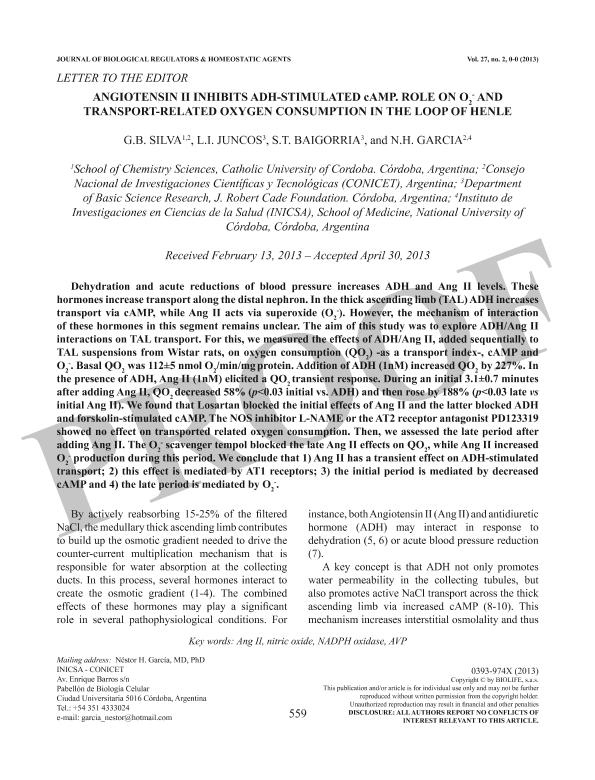Mostrar el registro sencillo del ítem
dc.contributor.author
Silva, Guillermo Benjamin

dc.contributor.author
Juncos, Luis Isaias

dc.contributor.author
Baigorria, S. T.
dc.contributor.author
Garcia, Nestor Horacio

dc.date.available
2017-09-06T14:24:37Z
dc.date.issued
2013-07
dc.identifier.citation
Silva, Guillermo Benjamin; Juncos, Luis Isaias; Baigorria, S. T.; Garcia, Nestor Horacio; Angiotensin II inhibits ADH-stimulated cAMP: role on O2- and transport-related oxygen consumption in the loop of Henle; Biolife Sas; Journal Of Biological Regulators And Homeostatic Agents; 27; 2; 7-2013; 569-578
dc.identifier.issn
0393-974X
dc.identifier.uri
http://hdl.handle.net/11336/23700
dc.description.abstract
Dehydration and acute reductions of blood pressure increases ADH and Ang II levels. These hormones increase transport along the distal nephron. In the thick ascending limb (TAL) ADH increases transport via cAMP, while Ang II acts via superoxide (O2-). However, the mechanism of interaction of these hormones in this segment remains unclear. The aim of this study was to explore ADH/Ang II interactions on TAL transport. For this, we measured the effects of ADH/Ang II, added sequentially to TAL suspensions from Wistar rats, on oxygen consumption (QO2) -as a transport index-, cAMP and O2-. Basal QO2 was 112+-5 nmol O2/min/mg protein. Addition of ADH (1nM) increased QO2 by 227 percent. In the presence of ADH, Ang II (1nM) elicited a QO2 transient response. During an initial 3.1+-0.7 minutes after adding Ang II, QO2 decreased 58 percent (p less than 0.03 initial vs. ADH) and then rose by 188 percent (p less than 0.03 late vs initial Ang II). We found that Losartan blocked the initial effects of Ang II and the latter blocked ADH and forskolin-stimulated cAMP. The NOS inhibitor L-NAME or the AT2 receptor antagonist PD123319 showed no effect on transported related oxygen consumption. Then, we assessed the late period after adding Ang II. The O2- scavenger tempol blocked the late Ang II effects on QO2, while Ang II increased O2- production during this period. We conclude that 1) Ang II has a transient effect on ADH-stimulated transport; 2) this effect is mediated by AT1 receptors; 3) the initial period is mediated by decreased cAMP and 4) the late period is mediated by O2-.
dc.format
application/pdf
dc.language.iso
eng
dc.publisher
Biolife Sas

dc.rights
info:eu-repo/semantics/openAccess
dc.rights.uri
https://creativecommons.org/licenses/by-nc-sa/2.5/ar/
dc.subject
Camp
dc.subject
Superoxide
dc.subject
Ang Ii
dc.subject
Tubular Transport
dc.subject.classification
Bioquímica y Biología Molecular

dc.subject.classification
Medicina Básica

dc.subject.classification
CIENCIAS MÉDICAS Y DE LA SALUD

dc.title
Angiotensin II inhibits ADH-stimulated cAMP: role on O2- and transport-related oxygen consumption in the loop of Henle
dc.type
info:eu-repo/semantics/article
dc.type
info:ar-repo/semantics/artículo
dc.type
info:eu-repo/semantics/publishedVersion
dc.date.updated
2017-09-04T15:07:24Z
dc.journal.volume
27
dc.journal.number
2
dc.journal.pagination
569-578
dc.journal.pais
Italia

dc.description.fil
Fil: Silva, Guillermo Benjamin. Universidad Catolica de Córdoba. Facultad de Ciencias Químicas; Argentina. Consejo Nacional de Investigaciones Científicas y Técnicas; Argentina
dc.description.fil
Fil: Juncos, Luis Isaias. Fundacion J. Robert Cade; Argentina
dc.description.fil
Fil: Baigorria, S. T.. Fundacion J. Robert Cade; Argentina
dc.description.fil
Fil: Garcia, Nestor Horacio. Consejo Nacional de Investigaciones Científicas y Técnicas. Centro Científico Tecnológico Conicet - Córdoba. Instituto de Investigaciones en Ciencias de la Salud. Universidad Nacional de Córdoba. Instituto de Investigaciones en Ciencias de la Salud; Argentina
dc.journal.title
Journal Of Biological Regulators And Homeostatic Agents

dc.relation.alternativeid
info:eu-repo/semantics/altIdentifier/url/http://www.biolifesas.org/contentsJBRHA.htm
Archivos asociados
